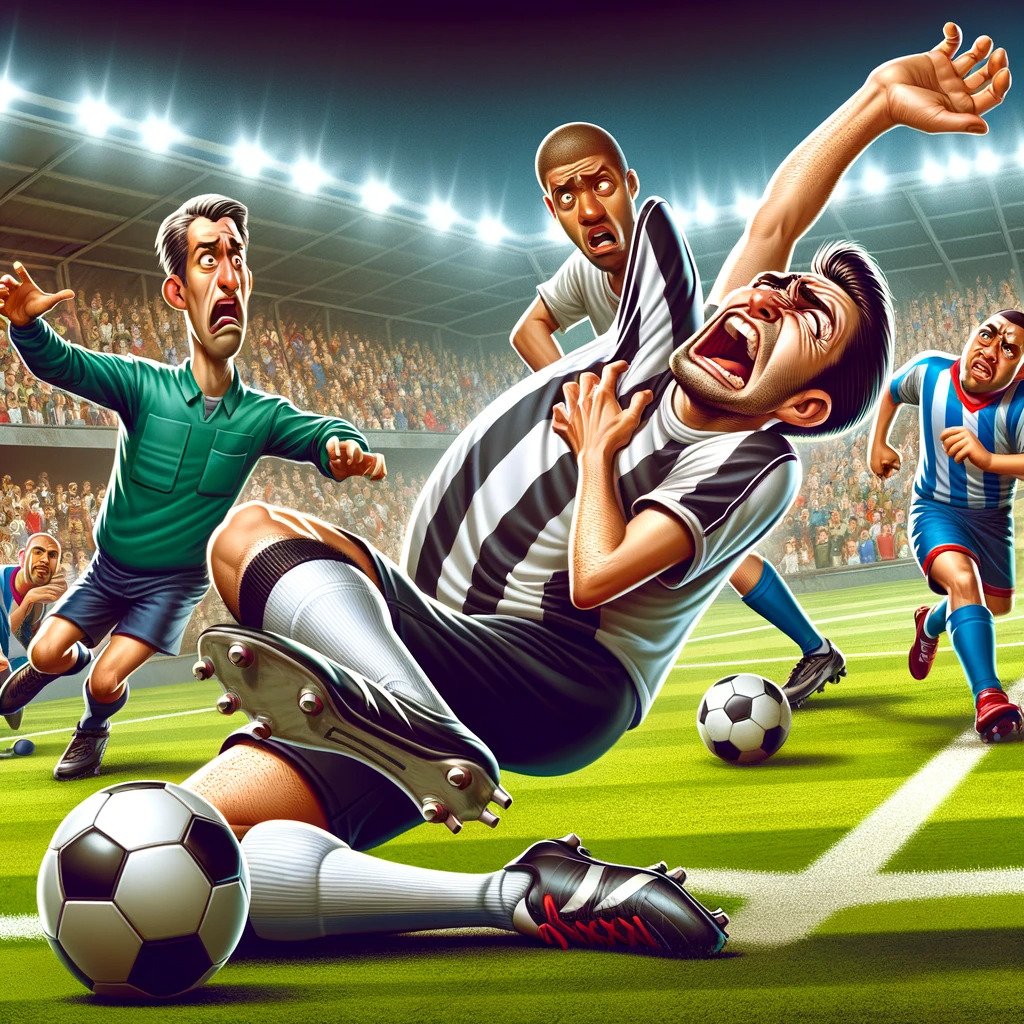In the world of football, commonly referred to as soccer in some regions, there’s an unfortunate yet prevalent practice that has been part of the sport for many years. This practice, often termed as diving or simulation, is essentially about players faking injuries. It’s a tactic that can rub fans the wrong way and often leave the players red-faced if not performed in a convincing manner. As someone who has watched numerous matches over the past 20 years, I’ve witnessed how referees have started to clamp down harder on this issue, particularly against dangerous tackles.
In this modern age, with thousands of cameras pointed at the pitch, it’s becoming increasingly challenging for players to get away with such acts. These cameras have made it easier to catch players out when they’re faking injuries or taking a dive.
The reputation of the sport takes a hit each time a player decides to indulge in this fake display of pain. It’s a tactic that can potentially disrupt the flow of the game and, in some cases, unfairly advantage a team. As the scrutiny from officials and technology grows, the hope is that this aspect of the game will see a decline, restoring the integrity and spirit of football. Anyways, lets try to find out why do soccer players exaggerate injuries in the first place.
Why do players exaggerate injuries?
In the competitive arena of football, a sport less intense in physical contact compared to other codes, the act of feigning injury plays a strategic role. Players often use this tactic for various reasons, but one common motive is to encourage the referee to take greater action against the opposition. This scenario unfolds particularly when an opponent is guilty of a foul during tackling. The player fouled might fake an injury to ensure that the offender is shown a yellow or even a red card.
The Influence of Exaggeration on Referees
Exaggerating the contact and its impact can significantly influence referees to enforce stricter action than they otherwise would. This act of embellishment, while frowned upon, is a calculated move to sway the game’s momentum.
Time Management through Fake Injuries
Another aspect where fake injuries come into play is in managing the time for one’s team. A player may pretend to have a serious injury that requires treatment to wind down the clock or give their side time to regroup. This tactic is particularly evident when a team is ahead in the dying stages of a match. Although injury time often accounts for these stoppages, it rarely evens out in the whole game, making the practice a common and frustrating occurrence for the opposing team and fans in general.
The Real Impact of Fake Injuries
While the act of faking injury is widely employed, it’s important to remember that serious injuries can and do occur. Therefore, a proper process is required for the safety of players, and this aspect should never be undermined by the theatrics of feigning harm.
Foul Simulation in Soccer
In the realm of soccer, a renowned contact sport, the art of foul simulation has become a tactical part of the game. Players often engage in this practice, simulating falls and injuries from actions like tripping or kicking.
While soccer is not extremely dangerous, as I discussed in my article “How Dangerous Soccer Really Is”, the risks involved in playing this sport, as compared to other sports, cannot be ignored. In many instances, these fouls, resulting from the game’s fast pace and a player’s inability to control their body, end up being unintentional.
The speed at which soccer is played, predominantly with the feet, makes it more common for players to go to the ground. This fact alone makes it easier for players to simulate a foul. The decision-making process of referees, often constrained to mere seconds, can be swayed by something as simple as a player’s scream, influencing whether a foul is sanctioned or not. In my experience in games, even a well-timed dramatic fall can alter a referee’s judgment.
Contrary to what many fans of other sports may think, soccer players are not soft. The excessive drama and faking seen on the field is a real strategy. Most soccer players are actually tough and intelligent guys, who may seem tough on the field but choose to fake being fragile at crucial moments to gain an advantage. This tactic is not about weakness but about being strategically astute, a point often missed by critics.
The Benefits of Exaggerating Injuries

Briefly, the benefits that a team gains from a player simulating a foul can be significant. It might result in a yellow or red card for an opponent, a penalty kick, or a direct or indirect freekick opportunity for the team. It can also cause frustration in the opposing team’s players, affecting their performance and strategy.
Yellow or Red Card for other team’s player
In the strategic landscape of soccer, the rule allowing the issuance of yellow or red cards creates an ideal scenario for simulating fouls. Unlike in other popular sports in the United States, such as baseball, football, or basketball, where sanctions don’t typically lead to a team playing with one player less than the opposing team for the rest of the game, soccer stands apart.
The referee’s decision to sanction a player with a card for a foul—considering its position on the field, intentionality, frequency, and roughness—can dramatically alter the game’s dynamics. When a player successfully simulates a foul, especially against an opponent who already has a yellow card, it can lead to them being thrown out of the game with a red card, thereby granting a significant advantage to the simulating player’s team.
Furthermore, this tactic is rarely seen in other sports. In basketball, for example, foul accumulation can lead to a player being thrown out, but the team is allowed to replace him and continue playing 5 against 5. The same thing happens in baseball or football for unsportsmanlike conduct. However, in soccer, the impact of simulating a foul can be greater and more consequential. While simulation may be harder and useless most of the time, in the context of the yellow and red card rule, it can seriously impact the game’s outcome.
Penalty Kick for the team
In the world of soccer, the penalty box plays a pivotal role in the game’s outcome. A foul simulation in this area is often strategically employed, as any foul within it is awarded a direct penalty kick against the goalkeeper. This tactic, quite common in modern soccer, significantly impacts the course of the game.
Unlike in other sports like basketball or football, where the average number of points (goals) per game is relatively high, soccer usually sees an average of only 2 goals per game. Thus, a team managing to score from a penalty kick gains a substantial advantage, making it much harder for the opposition to comeback and win. The act of faking a foul for a penalty kick can, therefore, be a decisive move in a closely contested match.
To compare, a penalty kick in soccer could be likened to a free throw in basketball. However, while a player simulating a foul in basketball might win 2 free throws, scoring a maximum of two points, it’s often not enough to decisively win a game, especially in leagues like the NBA where games typically see teams scoring upwards of 100 points.
On the other hand, in soccer, a single goal from a penalty kick can be game-defining. Faking a foul that leads to a penalty kick can result in a 1-0 final score, a frequent occurrence in soccer. This single goal can break the tie and potentially determine the winner for the rest of the match, highlighting the significant impact of penalty kicks in soccer.
Direct or Indirect Freekick
On the other hand, fouls in soccer are beneficial for a team not only when they occur inside the penalty box. Free throw strategies practiced outside the penalty area are integral to the playbook of many professional teams. In fact, some teams rely heavily on scoring from free throws after a foul is awarded. These moments are not just about regaining possession; they transform into critical scoring opportunities.
Even teams that are not very skillful with continuous play can make a significant impact on the game through great free throw takers or by being able to make effective crosses and score by air. This aspect of the game shows why soccer players often try to simulate fouls wherever they are on the field.
A stopped ball can change the momentum of the game. Teams that know how to play a stopped ball, whether it’s due to great free throw takers or the ability to make crosses and score by air, have enhanced chances of winning a game.
This strategic element underpins why soccer players frequently simulate fouls. It’s not merely about gaining a momentary advantage; it’s about opening up direct or indirect freekick opportunities that can decisively alter the outcome of the match. In soccer, every set piece is a potential game-changer, turning even the simplest of fouls into pivotal moments.
The Psychological Game
In the world of soccer, players often face frustration due to unfair decisions by referees. This is a common scenario, where the injustices within the game lead to significant tension on the field. Being a referee in soccer is undeniably hard, as they are constantly fighting against players who are trying to fake fouls. Imagine the challenge of work in such a high-pressure environment where every call can turn the tide of the game.
The implementation of technology in soccer has been retarded in comparison to other sports, which means that referees often have to make decisions solely from what they see, without the aid of instant replay. This lack of technological assistance has made simulation a successful and frustratingly effective tactic in the sport.
For a player, knowing you haven’t committed a foul and yet being sanctioned against it is VERY frustrating for the whole team. This feeling of helplessness and injustice can cause a team to lose their mind, making it even harder to play well and fight back. The psychological impact of these moments cannot be understated; they not only challenge the players’ focus but also affect the overall morale and strategy.
How VAR can prevent foul faking or simulation?

Referees, being humans, are bound to commit mistakes in the fast-paced environment of soccer. Players’ lack of honesty and their constant trying to simulate non-existent fouls make the job of officiating even harder. This has led to the need for more accurate decision-making mechanisms in the sport. Enter VAR (Video Assistant Referee), a recent implementation that marks a huge advancement in the fight against excessive drama and foul faking by soccer players.
Before VAR existed, referees had to make decisions based only on what they saw in real-time. They weren’t able to watch the replay to confirm if they made the right decision. In such a context, foul simulation was extremely useful for players, as the referee couldn’t go back and check if a player was actually simulating. VAR has dramatically changed this, as it is used exclusively in critical game situations like conflicted penalties and red cards.
Now, with VAR, players have to think twice if they want to simulate. Even if the referee awards a penalty, foul, or red card at first, they have the option to review it and turn back their decision. This can lead to the sanction of the simulating player with a yellow card, thereby discouraging the act of simulation.
However, it is still hard and expensive to implement VAR in all soccer leagues and games in the world. As of now, only the top leagues and tournaments have this technology. With time, we can expect to see VAR being implemented more and more around the world’s leagues, potentially reducing the instances of foul simulation in the game globally.
Do players get punished for faking injuries and diving?
Faking injuries and diving have been long-standing issues in soccer, but they are notoriously hard to detect and punish. However, in recent years, referees have targeted these actions more aggressively. When a player is spotted taking a dive or simulating contact, not only can a foul be called against them, but a yellow card can also be shown as a penalty. This change in refereeing approach indicates a growing intolerance towards deceptive plays in the sport.
With the introduction of VAR (Video Assistant Referee), the dynamics of addressing these issues have evolved further. Players are increasingly caught out in their attempts to win a penalty through simulation. VAR brings a new level of scrutiny, possessing the power to overturn an awarded spot-kick if replays suggest that there wasn’t adequate contact. This technological advancement has added a significant deterrent against simulation, making players think twice before indulging in such acts on the field.
Conclusion
The phenomenon of soccer players exaggerating injuries, a practice rooted in strategic gameplay and the limitations of human refereeing, is increasingly being addressed through advancements like VAR and a more vigilant approach from referees.
While it remains a challenge due to its subtlety and the high stakes of the game, the soccer world is evolving with technological aids and stricter enforcement to uphold the sport’s integrity. As these measures continue to improve, we can anticipate a reduction in the incentive for players to feign injuries, leading to a more authentic and fair display of the beautiful game.
Frequently Asked Questions
Why are there so many fake injuries in soccer?
Fake injuries in soccer are often a tactical strategy used by players to gain advantages such as free kicks, penalties, or to waste time. The high stakes of the game and the competitive nature of the sport contribute to this prevalence.
Why do football (soccer) players overreact to injuries?
Football players often overreact to injuries to draw the referee’s attention, hoping for favorable decisions like penalties, free kicks, or cards against opponents. This overreaction is sometimes used to break the flow of the game or to provide a brief respite for their team.
Why is men's soccer so dramatic?
Men’s soccer is dramatic due to the intense competition, high emotions, and the significant impact a single decision can have on the game’s outcome. Players often use dramatics as a psychological tactic to influence referees’ decisions and to disrupt the opposing team’s momentum.
What is it called when a soccer player fakes an injury?
When a soccer player fakes an injury, it is commonly referred to as “diving” or “simulating.” This act is done to deceive the referee into thinking a foul has occurred, aiming to gain an unfair advantage.
Why do soccer players flop so much?
Soccer players flop, or deliberately fall, to exaggerate contact or create the illusion of a foul. This tactic is employed to sway the referee’s decision in their favor, potentially leading to advantageous calls like penalties or free kicks. Flopping is also used to manage the game’s tempo or to disrupt the rhythm of the opposing team.

